
© Dave Morgan. (Click image for larger version)
Dutch National Ballet
Cinderella
London, Coliseum
8 July 2015
Gallery of pictures by Dave Morgan
www.operaballet.nl
Christopher Wheeldon’s emphasis in his narrative ballets is egalitarian. Love is his great leveller, breaking the barriers of the class system embedded in the stories he adapts: prince-and-pauper in Cinderella and The Winter’s Tale (although shepherdess Perdita is actually a princess), academic’s daughter and gardener’s boy in Alice’s Adventures in Wonderland.
His Cinderella, made in 2012 as co-production with Dutch National Ballet and San Francisco Ballet, comes between Alice and The Winter’s Tale and has elements of both. It’s conceived as a lavish entertainment, designs to the forefront, with plenty of featured roles and ensembles to keep a large ballet company busy. (DNB uses pupils and students from the National Ballet Academy, as well as members of its junior company.)

© Dave Morgan. (Click image for larger version)
He has two problems to contend with in Cinderella: Prokofiev’s prescriptive score and Ashton’s definitive choreography from 1948 – more familiar to British ballet audiences than to Dutch or American audiences. Wheeldon’s determination to avoid any similarity with Ashton’s choices means that he has to find other ways of using the music, overriding its descriptive passages and clock-ticking themes.
Together with his librettist, Craig Lucas, Wheeldon has based the fairy tale plot on the Brothers Grimm version rather than the more usual Perrault story, with its benevolent godmother and ‘glass’ slipper. Wheeldon provides a prologue accounting for the death of Cinderella’s mother (coughing up blood), funeral (umbrellas in the rain) and new stepfamily (pushy matron, quarrelsome sisters). A twiggy sapling sprouts from mother’s grave, watered by her daughter’s tears. Four male Fates, dressed in baggy black and blue outfits, lurk in the background.
Meanwhile at the royal palace, Prince Guillaume (William en français) is a naughty boy, playing with the butler’s son, Benjamin. They will remain mates as they grow up, swapping identities as in Rossini’s opera, La Cenerentola. They are also balletic relations of Siegfried and Benno: grown-up Guillaume (Matthew Golding, looking very boyish) is told his duty as heir is to pick a suitable fiançée, while Benjamin (Remi Wortmeyer) sympathises with his plight.
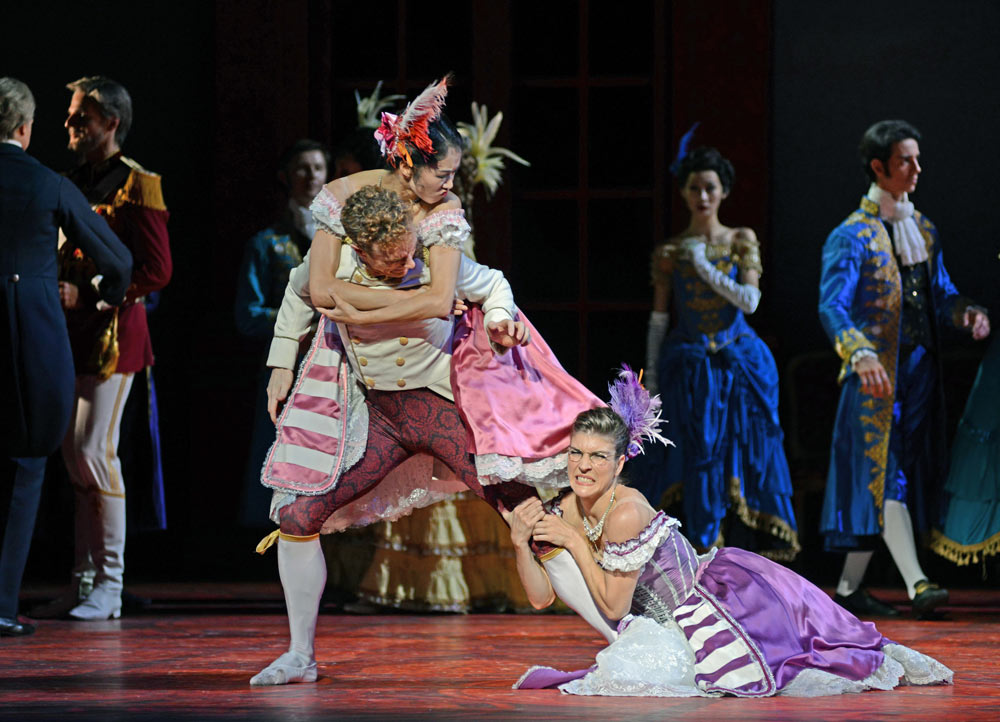
© Dave Morgan. (Click image for larger version)
We eventually catch up with adult Cinders (Anna Tsygankova) in the family kitchen, serving her stepsisters but also being carried around magically aloft by the Fates. To Prokofiev’s mysterious theme for the arrival of the fairy godmother, Guillaume turns up as a tramp, while Benjamin pretends to be the prince, hand-delivering invitations to the royal ball. So Cinderella meets her prince early on, during a lot of business with the stepmother and sisters in the foreground. Then, instead of wistfully imagining the ball from which she is excluded, Cinderella waltzes playfully with the ‘tramp’, whose intimacy looks rather creepy.
The Fates reappear to prepare her for crashing the ball. They introduce her to four sets of Spirits who emerge from beneath the branches of the huge magical tree on her mother’s grave. To music for the seasons, the Spirits bring her gifts of lightness, generosity, mystery and fluidity (all a girl needs), showing her steps she will dance at the ball. Wheeldon’s choreography is attractive, with plenty of beaten steps, ballon and spins. In avoiding Ashton’s enchaînements, however, Wheeldon ignores the distinctive phrasing of Prokofiev’s music illustrating the seasons.
He turns the ballabile Ashton used for the stars into a break-dancing routine for the Fates, followed by a parade of weird creatures who apparently warn Cinders to keep an eye on the time. Since there is no clock, the tick-tocking of the music lacks an urgent context. The transformation scene at the end of Act I is notable mainly for the dancing branches of the tree, and for Cinderella’s rapturous departure for the ball. The puppeteer Basil Twist devised the tree and the ‘carriage’ transporting her, manipulated by black-clad corps members and students. The fantastical sets, costumes and masks were designed by Julian Crouch, the lighting by Natasha Katz.
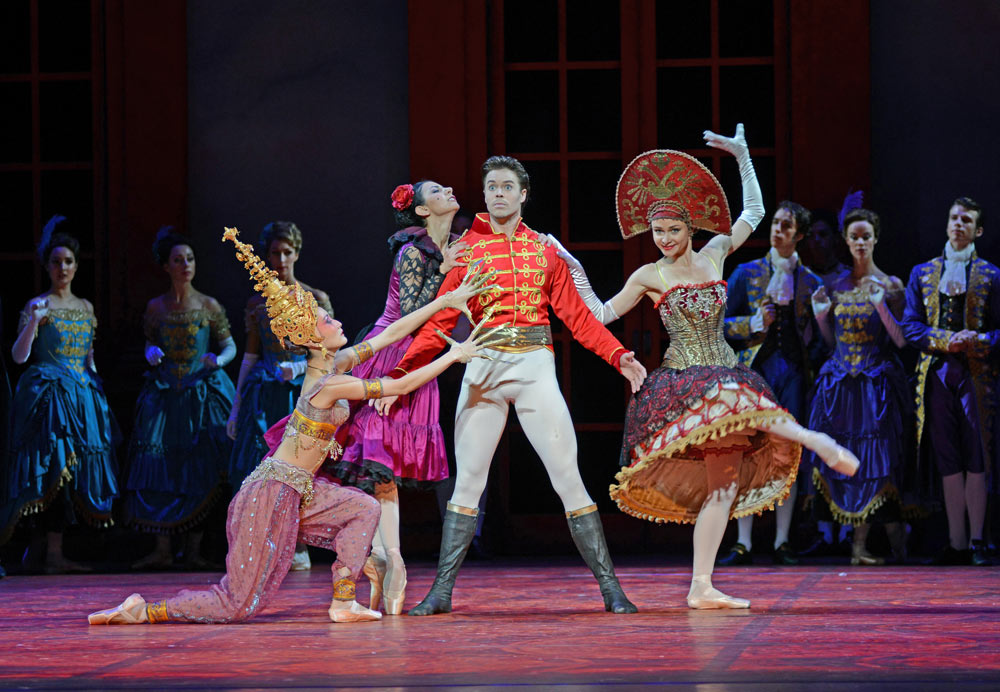
© Dave Morgan. (Click image for larger version
The ballroom scene in Act II is dominated by chandeliers overhanging dancing guests in vivid shades of blue and purple. Guillaume, in military scarlet, rejects three foreign would-be fiançées (Russian, Spanish and Balinese), who retire, miffed, with their escorts. He is unimpressed by the stepsisters, who fall out (and over) Benjamin, believing him to be the prince. Cinderella’s big arrival goes almost unnoticed because she, too, mistakes the prince’s identity.
So the Fates give her another entry to bedazzle him and us in her golden dress and mask. Wheeldon can’t seem to get rid of the tiresome foursome, having them watch over the falling-in-love pas de deux when they should be out of the picture. Maybe Cinderella relies on their presence to give her the confidence to dance, which she has scarcely done until now. Tsygankova makes her a fragile flower, cowed by her mistreatment, still in mourning for her mother. She dances delicately, with tendril arms and steely pointework. As Guillaume, Golding has a chance to show off manly leaps and a fine line, gazing romantically at his real-life partner.
Their pas de deux is pleasant, apart from some ungainly lifts, but unmemorable. Wheeldon daren’t employ Ashton’s simplicity in having Cinderella spin in chaîné turns around her entranced prince: this belle of the ball has to keep doing the steps the Spirits taught her in Act I instead of savouring being in love.

© Dave Morgan. (Click image for larger version)
Sub-plots attract attention away from the main affair. Benjamin pays court to the bespectacled younger sister, Clementine (Nadia Yanowsky). Imperious stepmother Hortensia (Larissa Lezhnina) hits the bottle, with delicious timing. When she rips off Cinderella’s mask in a drunken rage, the girl flees, belatedly aware of a deadline, leaving her gold pointe shoe behind. There’s no build-up to her departure, no threat of time running out.
Act III starts surprisingly, with a line-up of grotesques sitting on spindly chairs while the round-the-world music gallops along. When none of the contestants fit the shoe, the chairs dance up on wires to frame the kitchen set like a crown. The Fates are still there, helping with the housework as Cinders recalls the steps she danced at the ball. Once the prince has found her, the pair are transported to the magic tree where they kiss, lying down, side by side, as equals in love.
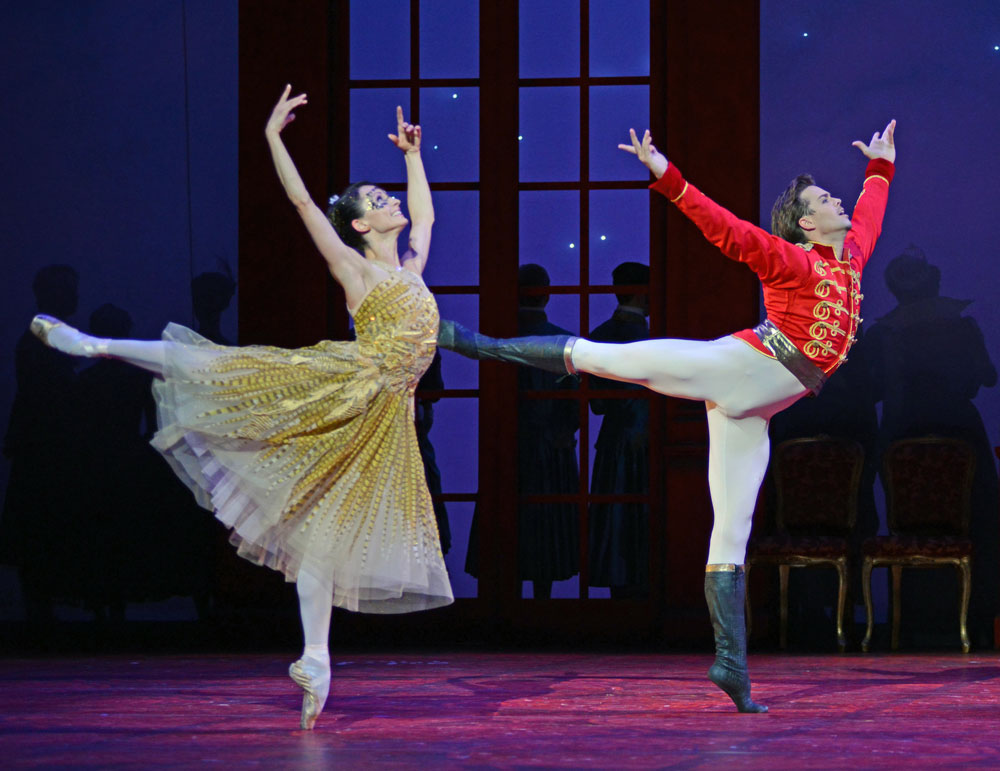
© Dave Morgan. (Click image for larger version)
They are joined by a multiplicity of couples in white, sharing their joy. Everyone is content, from Benjamin with silly Clementine to the various parents of the happy couples, royals and commoners. Cinderella and Guillaume have a new set of clothes and another pas de deux with ecstatic lifts. In spite of Wheeldon’s protestations that his is a darker version of the fairy tale than most other ballets, its anodyne message seems to be that fate will sort things out for the deserving (and not so deserving).
The Dutch company presents the production enthusiastically, well served by Birmingham Royal Ballet’s Sinfonia orchestra, conducted by DNB’s music director, Matthew Rowe. A pity, though, that Prokofiev’s score is so under-exploited. The dancers convey their belief in their roles, even if none of the characters have much depth: this Cinderella remains a fairy tale ballet, for all its democratic modern touches. As with Wheeldon’s Alice, the sets and puppeteering remain in the mind’s eye more vividly than the choreography. Good entertainment, but no classic for the future.













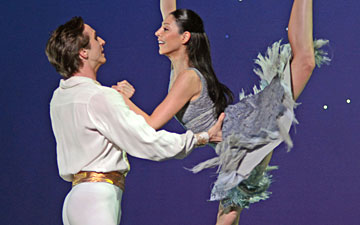

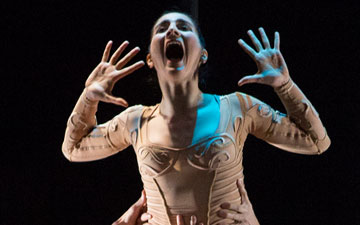
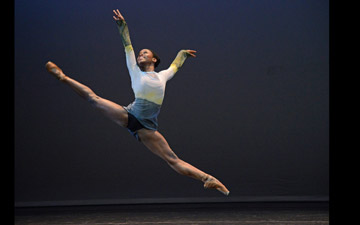
You must be logged in to post a comment.